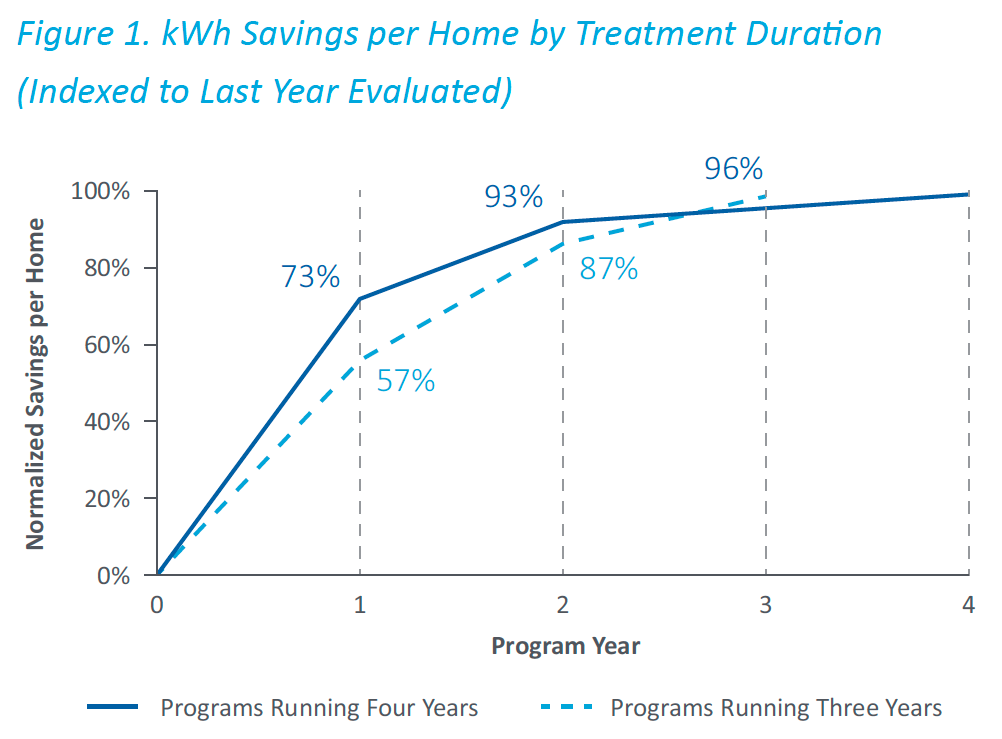This spinning blue sphere we call Earth is on the path toward an unlivable climate unless we achieve net zero emissions of greenhouse gasses by 2050, says a 2021 report from the United Nations. Energy efficiency could make up 40% of the emissions abatement needed within the next 20 years, but it’s going to take everyone – utilities and all their customers – moving in the same direction.
Right now, that’s not happening. Behavioral Energy Efficiency (BEE) programs are a popular utility initiative in residential markets – typically delivering 1% to 2% energy savings in their first couple of years, but customer savings drop off over time. To get consumers back on the energy efficiency journey, utilities need to empower them with the right information. It’s time for consumers to see real-time consumption data that shows what’s happening in the household so people can take action to improve home efficiency. The technology exists, and consumers who have access to it embrace it.
Concerns heat up
Today, 59% of Americans say global warming’s impacts are already underway, and 43% expect global warming to become a serious threat within their own lifetimes.
These worries haunt consumers and policy makers alike. Currently, 34 states have a climate change action plan or are developing one, and nearly half of the states have mandatory energy efficiency standards, while four others have voluntary targets. For utilities, meeting these multi-year efficiency mandates means getting residential customers on board with efficiency programs that continue to deliver significant savings over the course of several years rather than petering out.
The Deloitte 2020 Resources Study found that 68% of the 1,500 household decision makers surveyed agreed that, “I am very concerned about climate change and my personal carbon footprint,” while 38% expressed interest in home energy management systems. When it comes to getting data from utility apps or online portals, “getting actual consumption by appliance” was at the top of the residential consumer’s wish list. Nearly half – 44% – of survey respondents wanted it. Most aren’t getting it. If they are, that consumption data probably isn’t current, let alone real-time.
What works, what doesn’t
That’s the limitation with traditional Behavioral Energy Efficiency programs. Most are using customized Home Energy Reports (HERs) that leverage historical consumption and normative comparisons to motivate customers to use less energy by comparing their energy use with that of similar households. These reports have been around for more than a decade, and they’ve barely changed in all that time.
Early on, these programs garner 2% or more in savings from program participants, which isn’t bad for a piece of information that hits consumers via email or tucked into a bill stuffer once or twice a month. But the savings are not ongoing. A study conducted by researchers at The Cadmus Group found that responses to HER reports deliver their highest rate of energy efficiency savings during program year one. Participant efficiency efforts continue at a lower rate during program year two, but then level off in subsequent years.

Source: Cadmus Group
This shouldn’t be a surprise considering that the data supplied to customers is weeks old by the time it hits the customer’s mailbox. There’s no way for customers to see what’s happening at their homes in real time and take action to swap out power-hungry appliances, turn the air conditioner off when electricity is more expensive or detect unusual consumption that could signal an appliance is close to failure.
The Cadmus study also noted that program participants who “receive reports at higher frequencies (e.g., monthly instead of quarterly) tend to experience greater savings, especially at the beginning of the program when they are forming conservation habits.”
If monthly reports beat quarterly ones in gaining response, imagine what a smartphone app could inspire. After all, the global average amount of time consumers spent on apps during the first quarter of this year was 4.2 hours per day. Today’s consumers expect data-rich, on-demand, interactive experiences. They’re not getting them in traditional home energy reports.
Getting engaged
How can utilities get customers engaged in energy efficiency? Stop relying on paper bills and websites. Smart phone apps that deliver real-time energy consumption data dramatically boost conservation efforts compared to weeks-old data in the mail or hours-old data on a website that most customers visit intermittently. The Sense app disaggregates real time energy data from a customer’s entire home full of household appliances and devices and delivers instantaneous information.
Customers who purchase the Sense Home Energy Monitor open the app on average more than nine times per month. When Sense has worked with utilities to engage average customers, including Alliant Energy and Efficiency Vermont, customers opened the app an average of five times per month. This translates to a 500% increase in customer engagement compared to traditional opt-out utility emails and self-service web portals.
Engagement rises because real-time data matters to customers. It empowers them to find baseboard heating that’s been left on, locate the pool pump that uses too much electricity, or see the change in power consumption that lets them know the compressor is about to conk out in the refrigerator. All of this is possible because providing data to consumers through an in-app experience allows them to get real-time alerts, stay on top of household consumption and see what appliance in the home is racking up those high energy bills.
The need for current, device-specific information about the electricity running through our household walls will become even more important as more and more utility customers plug in electric vehicles or add solar panels to their rooftops. Second-generation smart meters on the market today must be designed to support the edge computing needed to make real-time, appliance-specific household energy data and insights easy for utilities to deliver. Landis+Gyr is the first to build these capabilities directly into the meter with Sense. Developed in collaboration with Sense, the new Revelo meter uses Sense technology to capture energy waveforms from electric devices in the home and uses machine learning and AI developed by Sense to translate that data into at-a-glance insight for consumers.
Progressive, innovative utilities are already taking steps to change how their customers think about energy. National Grid New York has selected Landis+Gyr’s Revelo meter for their upcoming AMI deployment. Revelo’s innovative design works as a platform for applications like the Sense app that prompt an entirely new level of sustained engagement and energy savings with utility customers.
It’s time for innovative utilities to put insights that consumers need for effective energy efficiency actions into the palms of their hands. Just as the iPhone revolutionized the mobile phone business by giving consumers more information and choices, Sense and Revelo are transforming the utility industry with a new generation of smart meters and apps that engage customers in true real time and empower energy efficiency programs that meet the challenges of climate change. Learn how you can bring Sense capabilities to your utility.
